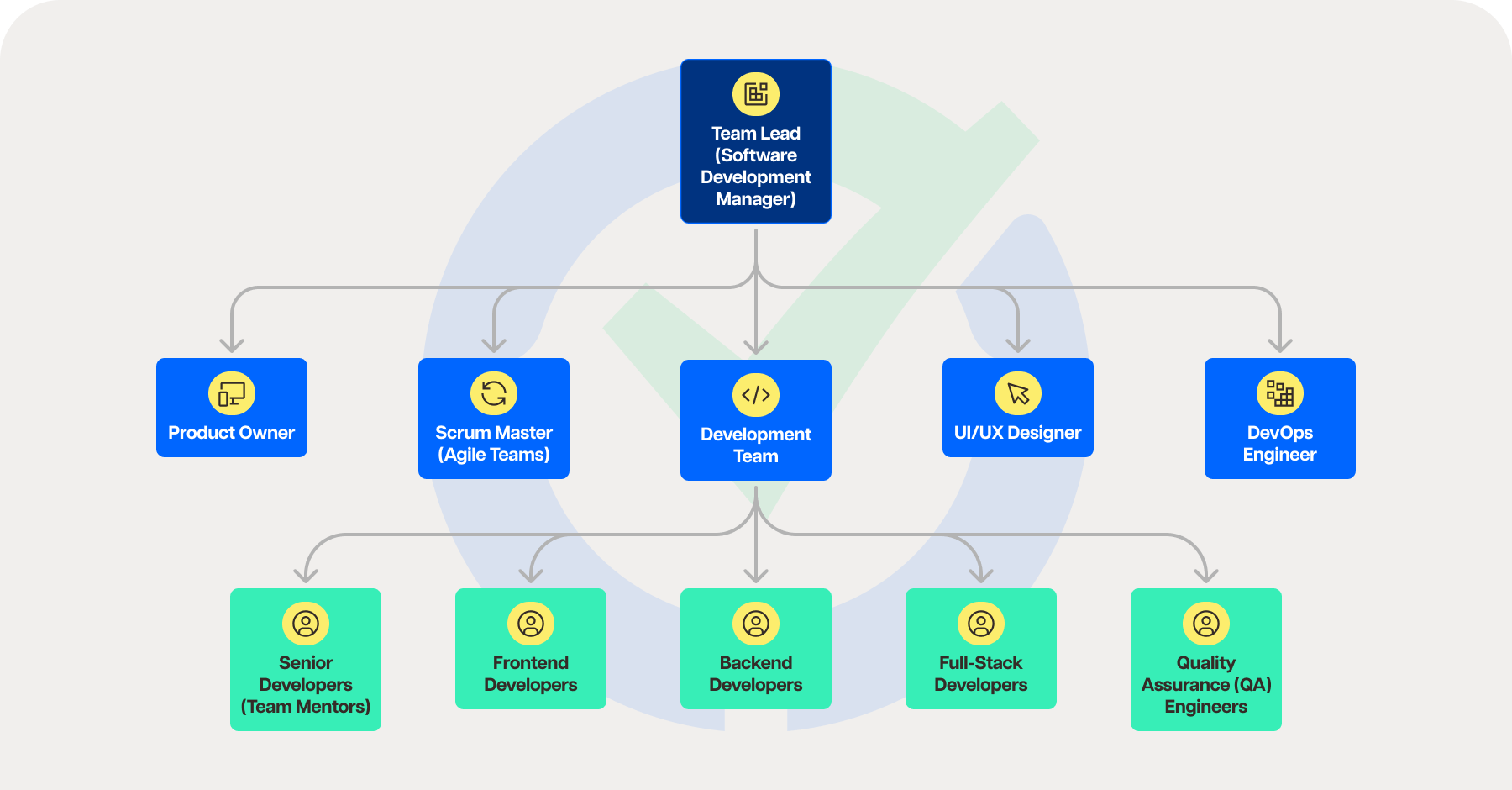The effectiveness of a software development team has a direct impact on an organization’s capacity for innovation, adaptation, and success in today’s fast-paced digital environment. An effective team requires highly qualified individuals and arranges them to optimize output and improve the caliber of the finished product.
This article explores the fundamentals of creating a productive software development team structure, provides an example of one, explains its hierarchy, and offers implementation best practices.
Table of Contents
- The essentials of an efficient software development team structure
- Sample software development team structure
- Best practices for implementing an efficient team structure
The essentials of an efficient software development team structure
Any software development team’s ability to succeed depends critically on having clearly defined roles and responsibilities. A development process that is more effective is facilitated by a clear grasp of each member’s roles, which helps to prevent miscommunication and unnecessary labor. Just as important is the establishment of clear channels of communication and decision-making processes. This ensures that all members of the team are in agreement with the project’s goals, facilitates the prompt resolution of issues, and keeps the project going forward.

Sample software development team structure
Consider a team structured as follows:
- Team lead (Software Development Manager): This person oversees the entire development process, from strategic decisions to resource management.
- Product owner: This person serves as the bridge between the development team and stakeholders, defining project goals and prioritizing tasks.
- Scrum master (for Agile Teams): Facilitates scrum processes and meetings, ensuring adherence to agile methodologies.
- Development team: Includes senior developers (acting as mentors), frontend and backend developers, full-stack developers, and quality assurance (QA) engineers.
- UI/UX designer: Focuses on designing the application interface and enhancing user experience.
- DevOps engineer: Responsible for automation strategies, deployment, integration, and ensuring system reliability.
This structure promotes efficiency and productivity by clearly delineating roles, fostering a collaborative environment, and allowing for scalable and adaptable team dynamics.

Best practices for implementing an efficient team structure
To adapt this structure to different organization sizes and types, consider the following tips:
- Maintain flexibility: Allow roles to evolve as projects progress and as team members grow and develop new skills.
- Encourage cross-functional collaboration: While roles are defined, encourage learning and collaboration across different areas to foster innovation.
- Scale according to need: Adjust the size of the team and the number of roles based on project requirements and organizational capacity.
The challenges and solutions involved in structuring software development teams provide deeper insights into navigating common obstacles. Here’s a closer look:
Challenges
- Balancing roles: Choosing the right combination of jobs for a team can be challenging. A team with too few responsibilities may feel overworked, whereas a team with too many roles may become disorganized and ineffective.
- Clear communication: Ensuring that all team members are on the same page, especially in a remote or distributed team environment, poses significant challenges. Miscommunications can delay projects and affect quality.
- Maintaining flexibility: Software development is dynamic, with requirements and technologies evolving rapidly. Teams must remain flexible to adapt to changes without sacrificing productivity or morale.
- Integration of new technologies: It can be challenging to adopt new technologies and keep up with them without interfering with ongoing projects or workflows; this calls for strategic planning and training.
- Cultural alignment: Long-term success depends on designing a team structure that is consistent with the values and culture of the organization. Misalignment can lead to conflicts and reduced efficiency.

Solutions
- Regular team assessments: Finding areas for realignment can be facilitated by regularly reviewing the performance and structure of the team. Evaluations can indicate whether a role is being overworked or underutilized, enabling prompt modifications.
- Communication tools and protocols: Projects can be kept on schedule and misconceptions reduced by making an investment in dependable communication technologies (such as Slack, Microsoft Teams, or Asana) and developing explicit communication standards.
- Agile methodologies: Using agile approaches like Scrum or Kanban helps improve adaptability. These frameworks place a strong emphasis on constant feedback, iterative development, and change adaptation.
- Continuous learning and development: Encouraging ongoing education and providing resources for learning new technologies can ease the integration of innovations into projects. This also helps in keeping the team’s skills up to date.
- Cultural workshops and team building: Teams can become more cohesive and well-aligned by participating in activities that support the company’s culture and values. Workshops and team-building exercises can also help to increase cooperation and mutual respect.
Organizations can build more effective, cohesive, and flexible software development teams that can take on challenging projects and spur innovation by addressing these issues with focused solutions.
Conclusion
An organization’s ability to succeed depends critically on the makeup of its software development team. Organizations may boost team performance, productivity, and creativity by being adaptable, fostering effective communication, and clearly defining roles.The frameworks supporting the teams navigating this environment need to change along with the digital ecosystem.

Andy is a technology & marketing leader who has delivered award-winning and world-first experiences.


